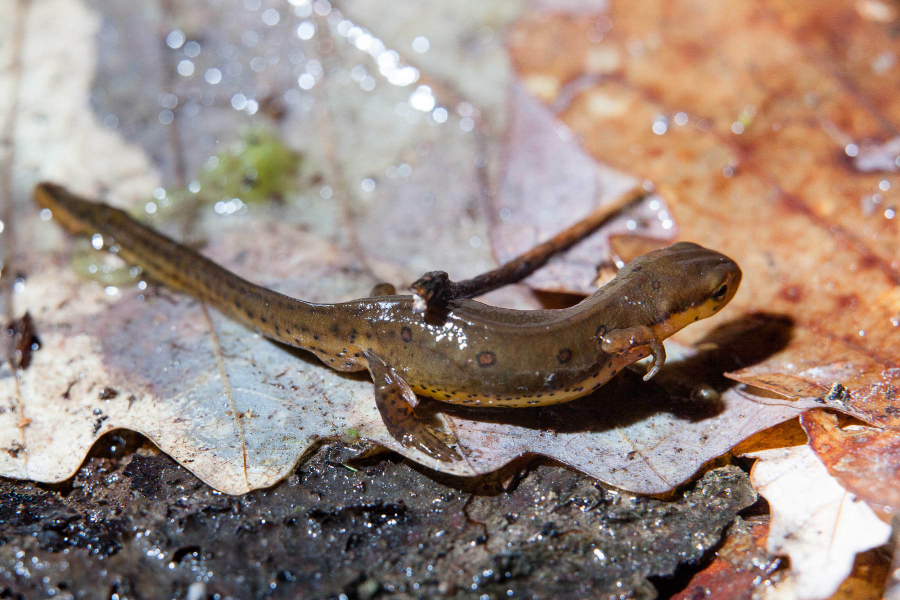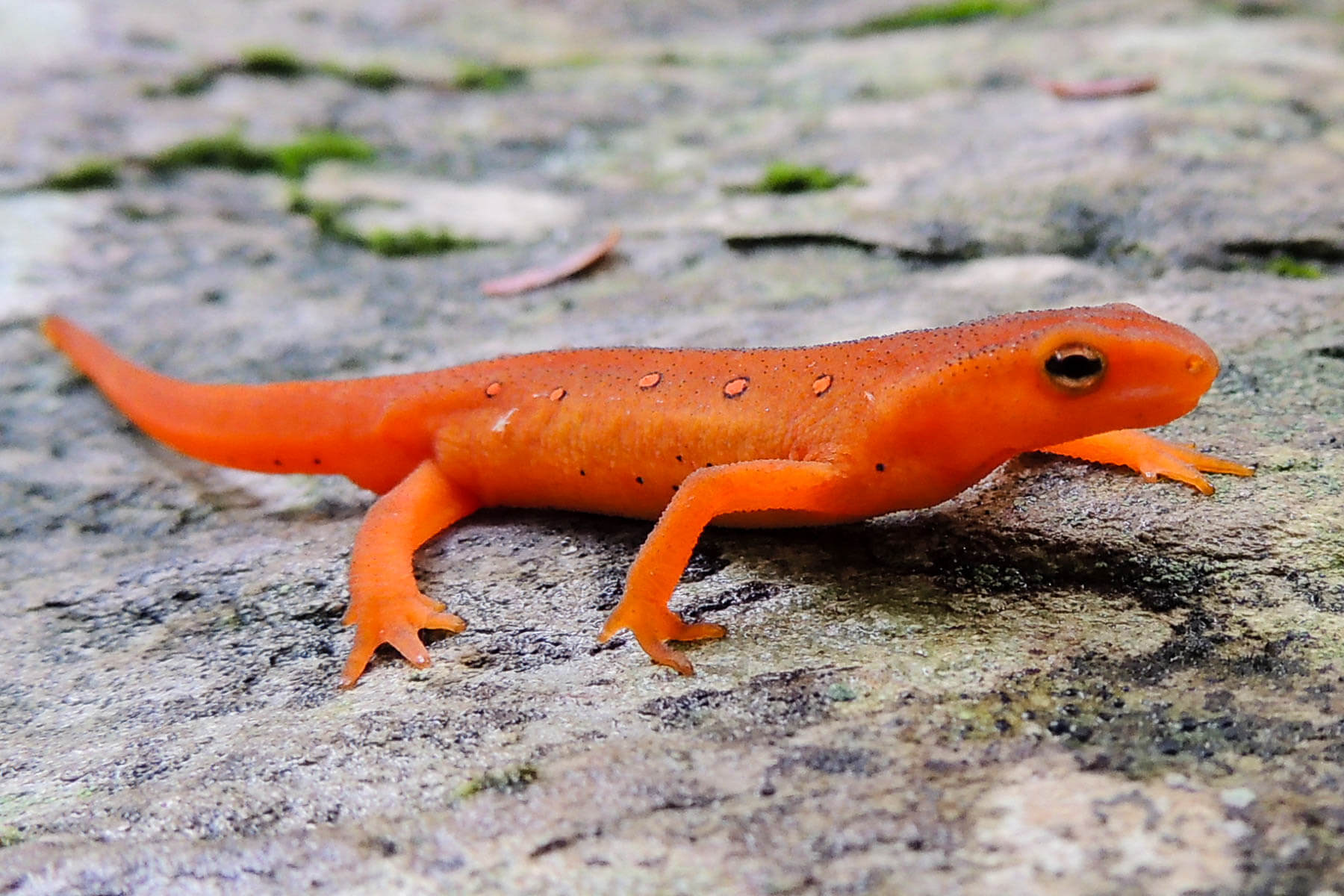Exploring the unique "triple life" of an eastern newt

Eastern newts, like most amphibians, start as aquatic larvae and move to living on land. But what makes this critter unique is that after a few years living among leaf litter on the forest floor, it will become aquatic once again. Looking at the size, color and habitat of where you spot an eastern newt can help you determine what stage it’s in.
In the first stage of the life cycle, egg masses are laid on underwater grasses in ponds, lakes and marshes. Larvae hatch a few weeks later and are an olive-green color that blend in with the murky water they live in. The larvae measure less than an inch when they hatch, have external gills and spend most of their time eating small invertebrates.
After 2-5 months in its aquatic larvae stage, the eastern newt develops lungs to live on land. Its green color changes to bright orange or red and the newt has orange spots with black borders on its back. The brightly colored terrestrial juvenile (also known as an eft) measures 1-3 inches long and will live on land for 2-3 years.

Efts are easy to spot because of their bright colors and prevalence in forests, but also because of a unique survival technique that keeps predators away. The eastern newt’s skin has glands that secrete a neurotoxin called tetrodotoxin, which is strongest in the eft stage. The bright orange color of the eastern newt signifies danger to other animals and makes them unappealing and sometimes fatal to predators that try to eat them.
The eastern newt’s toxicity is not harmful to humans from just holding the creature, only ingesting it can cause serious harm. Touching an eastern newt with your bare hands and then rubbing your eyes or putting something in your mouth without washing your hands first can cause irritation, so be careful if you spot an eastern newt in the wild and decide to pick it up.
After the juvenile stage, the eastern newt will move to the water once again. The adult newt measures between four and five inches long. They can live on land if the water it lives in dries up, but will mostly live in the water, regain its green color and develop a tail fin to help it swim.
In certain situations, some eastern newt populations will skip the juvenile eft stage entirely. Scientists are not entirely clear about what triggers this phenomenon but some eastern newts will retain their external gills from their immature larvae stage and move straight to the adult stage and never live on land. This is called neoteny, which is something that has been observed in other salamanders as well.
Skipping the juvenile stage is more common in coastal populations of the eastern newt and this life cycle adaptation tends to be seen in areas where the land habitat may be challenging to live in.
The eastern newt population is stable and they are commonly found in the Chesapeake Bay watershed, so keep your eyes peeled for a dart of orange among the leaf litter or green newt swimming in a pond or lake.
Even though the eastern newt is not threatened or endangered, keeping local waterways healthy is important to preserve the habitat of this unique amphibian. Using fewer pesticides in your garden or lawn, cutting back on fertilizer and picking up after your pet are all ways to improve the health of your local waterways and keep the homes of the eastern newt and many other animals livable.

Comments
Hey! I have just homed what I have just now re - identified as a red eft due to colorization and the fact that I found it on a rather dry trail. after some of my minor research I wasent aware of it's triple life cycle!! So I put it in a mostly aquatic tank as I was told was normal for an eastern newt... and it swam like a pro. I know I'm not supposed to handle it much but I wanted to make sure it enjoyed the water so I removed it a few times and put it on the island I have made for it in the tank, it would instantly dive back in the water and swim like a champion or hover at the bottom then swim back up for air every 2-3 minutes before going back to the bottom, it is about 2 1/2 - 3 inches in length would I be correct to assume that it is a red eft in its latest stages of that cycle? It truely swims like a natural. Thank you!! I apologize for my ignorance but I feel such an intense admiration for these curious creatures!!!!!! I want to get him friends asap! Do red efts get along with their adult Eastern Newt counterparts ?
My sense is the eft stage helps populations as an insurance against winter-kill of the portion of the population that overwinters in ponds. Winter kill happens some years, not all, when ice/snow prevent O2 entering pond from air or being produced by photosynthesis (shade from snow). I've seen this in our own pond in Sullivan County - hundreds of dead adult newts (and fish and tadpoles). The red efts overwinter on the land (I assume) and are thus way for populations to recover between winter kills.
Hi, Tim! Glad you found the blog helpful. Juveniles live on land for about 2-3 years and the full life span of the eastern newt is 12-15 years, so they will likely live in the water around 10 years.
Thank you, I've been watching the terrestrial juveniles all my life and did not connect them with adult green swimmers I'm also familiar with. Two years a juvenile is another interesting bit. How long will adults live in the water?
Thank you!
Your comment has been received. Before it can be published, the comment will be reviewed by our team to ensure it adheres with our rules of engagement.
Back to recent stories